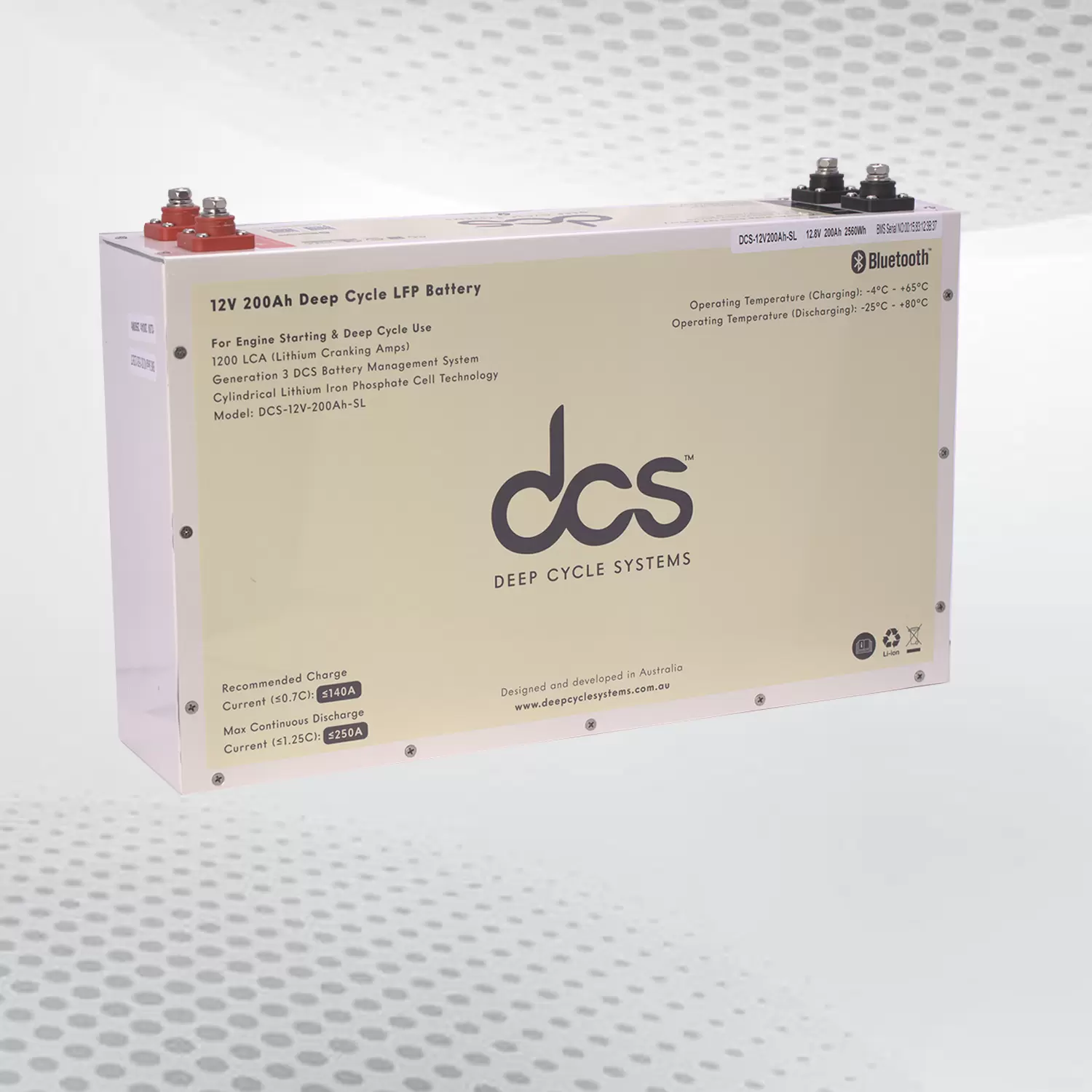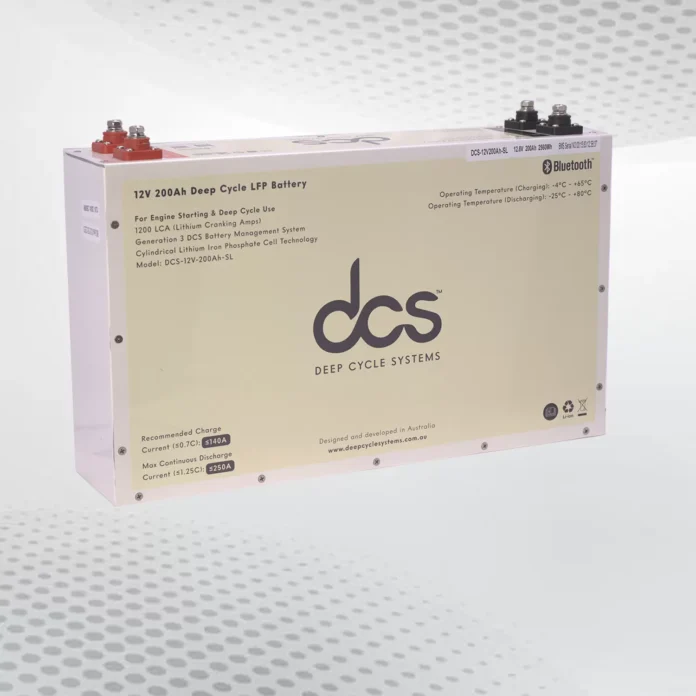In today’s fast-paced world, having a reliable energy source is crucial for both individuals and businesses. One solution that has been gaining popularity is the 200 amp hour lithium battery. This high-capacity battery offers long-lasting power and is perfect for various applications. In this blog post, we will explore the benefits of investing in a 200-ah lithium-ion battery, choosing the best one for your needs, top applications for this type of battery, maintenance tips, maximising its lifespan, and the future of high-capacity lithium batteries.
Understanding the 200 Amp-Hour Lithium Battery
The 200 amp-hour lithium battery stands as a formidable force in energy solutions, distinguishing itself through its ability to deliver substantial power for prolonged durations. This type of battery is integral to various systems that demand consistent and reliable energy, such as off-grid solar setups, electric vehicles, and emergency backup power sources. What sets the 200-ah lithium battery apart is its remarkable energy density. This characteristic facilitates the storage of a more significant amount of energy within a more compact and lightweight unit and contributes to the battery’s overall efficiency and performance.
The longevity of lithium-ion batteries, evidenced by their extensive cycle life, underscores their reliability. This means they can endure numerous charge and discharge cycles while retaining their capacity, thus ensuring a stable power supply over time. Their application extends across a diverse spectrum, from powering remote installations like cabins and RVs to sustaining critical systems in marine environments and electric transportation. The adaptability and robustness of the 200-ah lithium battery make it an indispensable component in modern energy systems, showcasing the evolving landscape of power storage technologies.
 The Benefits of investing in a 200-ah lithium-Ion Battery
The Benefits of investing in a 200-ah lithium-Ion Battery
Investing in a 200-ah lithium-ion battery brings many advantages beyond its primary energy storage function. Key among these is the superior energy density that lithium-ion technology offers. This characteristic allows for a more compact and lightweight solution than conventional batteries, making it ideal for a wide range of mobile and stationary applications. Another significant advantage is the extended cycle life of lithium-ion batteries. They are designed to endure many charge and discharge cycles with minimal capacity loss, translating to a longer service life and fewer replacements over time.
These batteries exhibit exceptional efficiency in both charging and discharging, which contributes to energy conservation and ensures a steady power supply when needed. The reduced self-discharge rate of lithium-ion batteries is another benefit, ensuring that the battery retains its charge for more extended periods when not in use. This feature is handy for applications where the battery is not regularly charged, such as seasonal recreational vehicles or emergency backup systems.
The environmental footprint of lithium-ion batteries is smaller due to their longer lifespan and the absence of heavy metals like lead and cadmium, which are found in some traditional batteries. This makes them a more sustainable option for reducing their ecological impact. The adaptability of 200-ah lithium-ion batteries to various climates and conditions underscores their reliability and versatility in meeting energy needs across diverse settings and applications.
How to Choose the Best 200Ah Lithium Battery for Your Needs?
Selecting the best 200Ah lithium battery requires careful consideration of several factors to ensure it effectively meets your specific energy needs. Here are key points to guide you through the decision-making process:
Application Compatibility
Determine the primary use of your battery. Different applications like solar energy storage, electric vehicles, or portable power solutions may have unique power demands. Ensure the battery you choose is suited for your specific application.
Energy Density and Weight
Consider the energy density and weight of the battery. A higher energy density means more power in a lighter, more compact package, which is particularly important for mobile applications where space and weight are critical factors.
Cycle Life
Look at the battery’s cycle life, indicating how many charge and discharge cycles the battery can undergo before its capacity diminishes to a certain percentage of its original capacity. A longer cycle life translates to greater longevity and value for money.
Temperature Tolerance
Assess the battery’s tolerance to temperature variations. Extreme temperatures can significantly affect the battery’s performance and lifespan, so choose a battery that can operate efficiently within the climate conditions it will be exposed to.
Charging Time
Evaluate the charging speed of the battery. If quick charging is essential for your application, look for batteries that support fast charging technologies.
Top Applications for a 200-ah lithium Battery
The versatility of the 200-ah lithium battery makes it an essential component in many settings, where its substantial storage capacity and efficiency can be fully utilized. For instance, it has become a cornerstone in off-grid solar systems, providing the necessary energy storage to ensure a steady power supply, even in periods of low sunlight. Electric vehicles (EVs) also benefit significantly from these batteries’ high energy density and long cycle life, enabling longer distances on a single charge and contributing to the EVs’ overall sustainability.
In marine applications, the durability and robustness of 200-ah lithium batteries are invaluable. They reliably power navigational systems, onboard appliances, and lighting, even in harsh sea conditions. Backup power systems, particularly in critical settings like hospitals or data centers, depend on lithium-ion batteries’ reliability to maintain operations during power outages.
Portable power stations equipped with these batteries offer convenient and mobile power solutions for outdoor events, construction sites, and emergency relief efforts, showcasing their adaptability. Recreational vehicles (RVs) and camping trailers, where space and weight are at a premium, leverage these batteries to enhance the off-grid living experience, providing comfort and convenience far from traditional power sources. This broad applicability underlines the 200-ah lithium battery’s role as a pivotal energy solution, catering to various power needs across different landscapes and sectors.
Maintenance Tips for Your 200-ah lithium-Ion Battery
Maintaining your 200-ah lithium-ion battery is crucial to ensure optimal performance and extend operational life. Start by adhering to the manufacturer’s recommendations for charging and discharging practices, as improper handling can significantly affect the battery’s health. Regularly check the battery’s state of charge and avoid letting it fall into a deep discharge state, as this can be detrimental to its longevity.
Ensure that the battery is charged using a compatible charger that matches its specifications to prevent overcharging, which can lead to overheating and potential damage. Temperature management is another vital aspect of battery maintenance. Lithium-ion batteries operate best within a specific temperature range, usually between 20°C and 25°C (68°F and 77°F).
Storing the battery in too hot or cold conditions can impair its ability to hold a charge and reduce its lifespan. Therefore, finding a cool, dry place for storage when the battery is not in use is critical. Periodically inspect the battery for any wear or damage, including the terminals and casing. Clean any corrosion from terminals to ensure a good connection and prevent power loss. Implementing these maintenance tips can significantly contribute to the health and efficiency of your 200-ah lithium-ion battery, supporting its role as a dependable power source for your needs.
Maximizing the Lifespan of Your 200Ah Lithium Battery
A few strategic practices are essential to extend the durability and efficiency of your 200Ah lithium battery. It is vital to avoid letting the battery discharge too profoundly regularly. Deep discharges can strain the battery and shorten its useful life. Conversely, it is equally important not to overcharge the battery, as this can lead to overheating and potential damage over time.
Temperature regulation plays a crucial role in preserving battery life. Keeping the battery within a moderate temperature range, ideally between 20°C and 25°C (68°F and 77°F), can significantly reduce the risk of capacity loss and maintain optimal performance. During periods of non-use, storing the battery in a cool and dry environment helps prevent the degradation of its internal components.
Regular cycling of the battery—by periodically allowing it to discharge to about 50% before recharging it fully—helps maintain its health and ensures a more accurate reading of the battery’s state of charge. Additionally, conducting routine maintenance checks, including inspecting for any physical damage or wear and cleaning the terminals to ensure a solid connection, can prevent unforeseen issues and keep the battery running efficiently for its intended lifespan.
The Future of High-Capacity Lithium Batteries
The horizon for high-capacity lithium batteries is dotted with promising innovations to revolutionise power storage. As the demand for efficient, durable, and compact energy solutions grows, researchers are honing in on novel lithium-ion technologies to surpass current limitations. One exciting avenue is the development of solid-state batteries, which promise significantly enhanced safety profiles and energy densities compared to their liquid electrolyte counterparts.
This leap forward could dramatically reduce the risk of battery fires and increase the energy a battery can store, opening new possibilities for electric vehicles and renewable energy storage systems. Simultaneously, efforts are underway to reduce charging times dramatically, making high-capacity batteries more convenient for everyday use. Imagine electric vehicles that charge as quickly as it takes to fill a gas tank or mobile devices that reach total capacity in minutes rather than hours.
Sustainability remains a key focus, with ongoing research into more environmentally friendly materials and recycling processes to ensure that the future of high-capacity lithium batteries is powerful and green. By pushing the boundaries of current technology, these innovations significantly impact how we store and use energy, propelling us into a future where the limitations of battery capacity and longevity are a thing of the past.
Conclusion
Embracing a 200 amp hour lithium battery represents a significant stride toward efficient and sustainable energy solutions. Its versatility, longevity, and robust performance underpin its growing popularity across various sectors, promising a future where energy reliability and eco-consciousness go hand in hand. As we continue to innovate and refine battery technology, the potential for these powerhouses to transform our energy landscape becomes ever more evident. Engaging with this technology elevates our immediate power capabilities and contributes to a broader movement towards cleaner, more sustainable energy utilization for future generations.
FAQs
Q: How long does a 200-ah lithium battery last on a single charge?
A: The battery’s duration on a single charge depends on the devices or applications it’s powering. To estimate, divide the total watt-hours your device uses by the voltage of your battery, then compare this to the 200Ah capacity.
Q: Can I connect multiple 200-ah lithium batteries in parallel or series?
A: You can connect these batteries in parallel to increase capacity (Ah) for more extended usage or in series to increase voltage (V) for higher power requirements. However, ensure all batteries are of the same type and age to prevent imbalance.
Q: Are 200-ah lithium batteries environmentally friendly?
A: Lithium-ion batteries are more eco-friendly than traditional lead-acid batteries due to their longer lifespan, absence of heavy metals, and higher energy density, which reduces waste and energy consumption.
Q: How should I dispose of or recycle my 200 amp hour lithium battery?
A: Do not dispose of 200 amp hour lithium battery in regular trash due to potential environmental harm. Many retailers and local waste management facilities offer recycling programs for lithium-ion batteries.
| Other Good Articles to Read |
| Blogs Rain |
| Cme Blog Spot |
| Garcias Blogs |
| Yyc Blogs |
| Guiade Blogs |
| Blogs-Hunt |
| Impact-Blog |
| Smarty Blogs |
| Ed Blog |
| Mo Blogs |
| Blogs Em |
| Blogs T |
| Related Business Listings |
| Contact Directory |
| Local Business Profiles |

